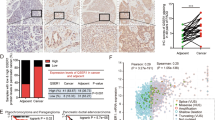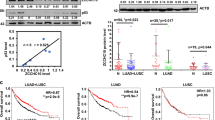Abstract
RNF2, also known as Ring1B/Ring2, is a component of the polycomb repression complex 1. RNF2 is highly expressed in many tumors, suggesting that it might have an oncogenic function, but the mechanism is unknown. Here, we show that knockdown of RNF2 significantly inhibits both cell proliferation and colony formation in soft agar, and induces apoptosis in cancer cells. Knockdown of RNF2 in HCT116 p53+/+ cells resulted in significantly more apoptosis than was observed in RNF2 knockdown HCT116 p53−/− cells, indicating that RNF2 knockdown-induced apoptosis is partially dependent on p53. Various p53-targeted genes were increased in RNF2 knockdown cells. Further studies revealed that in RNF2 knockdown cells, the p53 protein level was increased, the half-life of p53 was prolonged and p53 ubiquitination was decreased. In contrast, cells overexpressing RNF2 showed a decreased p53 protein level, a shorter p53 half-life and increased p53 ubiquitination. Importantly, we found that RNF2 directly binds with both p53 and MDM2 and promotes MDM2-mediated p53 ubiquitination. RNF2 overexpression could also increase the half-life of MDM2 and inhibit its ubiquitination. The regulation on p53 and MDM2 stability by RNF2 was also observed during the etoposide-induced DNA damage response. These results provide a possible mechanism explaining the oncogenic function of RNF2, and because RNF2 is important for cancer cell survival and proliferation, it might be an ideal target for cancer therapy or prevention.
This is a preview of subscription content, access via your institution
Access options
Subscribe to this journal
Receive 50 print issues and online access
$259.00 per year
only $5.18 per issue
Buy this article
- Purchase on Springer Link
- Instant access to full article PDF
Prices may be subject to local taxes which are calculated during checkout







Similar content being viewed by others
References
Ringrose L, Paro R . Epigenetic regulation of cellular memory by the Polycomb and Trithorax group proteins. Annu Rev Genet 2004; 38: 413–443.
Levine SS, King IF, Kingston RE . Division of labor in polycomb group repression. Trends Biochem Sci 2004; 29: 478–485.
Lund AH, van Lohuizen M . Polycomb complexes and silencing mechanisms. Curr Opin Cell Biol 2004; 16: 239–246.
Cao R, Wang L, Wang H, Xia L, Erdjument-Bromage H, Tempst P et al. Role of histone H3 lysine 27 methylation in Polycomb-group silencing. Science 2002; 298: 1039–1043.
Kuzmichev A, Nishioka K, Erdjument-Bromage H, Tempst P, Reinberg D . Histone methyltransferase activity associated with a human multiprotein complex containing the Enhancer of Zeste protein. Genes Dev 2002; 16: 2893–2905 PMCID: 187479.
Kirmizis A, Bartley SM, Kuzmichev A, Margueron R, Reinberg D, Green R et al. Silencing of human polycomb target genes is associated with methylation of histone H3 Lys 27. Genes Dev 2004; 18: 1592–1605.
Wang H, Wang L, Erdjument-Bromage H, Vidal M, Tempst P, Jones RS et al. Role of histone H2A ubiquitination in Polycomb silencing. Nature 2004; 431: 873–878.
Fischle W, Wang Y, Jacobs SA, Kim Y, Allis CD, Khorasanizadeh S . Molecular basis for the discrimination of repressive methyl-lysine marks in histone H3 by Polycomb and HP1 chromodomains. Genes Dev 2003; 17: 1870–1881.
Boyer LA, Plath K, Zeitlinger J, Brambrink T, Medeiros LA, Lee TI et al. Polycomb complexes repress developmental regulators in murine embryonic stem cells. Nature 2006; 441: 349–353.
Lee TI, Jenner RG, Boyer LA, Guenther MG, Levine SS, Kumar RM et al. Control of developmental regulators by Polycomb in human embryonic stem cells. Cell 2006; 125: 301–313.
Sparmann A, van Lohuizen M . Polycomb silencers control cell fate, development and cancer. Nat Rev Cancer 2006; 6: 846–856.
Varambally S, Dhanasekaran SM, Zhou M, Barrette TR, Kumar-Sinha C, Sanda MG et al. The polycomb group protein EZH2 is involved in progression of prostate cancer. Nature 2002; 419: 624–629.
Kleer CG, Cao Q, Varambally S, Shen R, Ota I, Tomlins SA et al. EZH2 is a marker of aggressive breast cancer and promotes neoplastic transformation of breast epithelial cells. Proc Natl Acad Sci USA 2003; 100: 11606–11611.
Ougolkov AV, Bilim VN, Billadeau DD . Regulation of pancreatic tumor cell proliferation and chemoresistance by the histone methyltransferase enhancer of zeste homologue 2. Clin Cancer Res 2008; 14: 6790–6796.
Kalushkova A, Fryknas M, Lemaire M, Fristedt C, Agarwal P, Eriksson M et al. Polycomb target genes are silenced in multiple myeloma. PLoS One 2010; 5: e11483.
Fujii S, Ito K, Ito Y, Ochiai A . Enhancer of zeste homologue 2 (EZH2) down-regulates RUNX3 by increasing histone H3 methylation. J Biol Chem 2008; 283: 17324–17332.
Yang X, Karuturi RK, Sun F, Aau M, Yu K, Shao R et al. CDKN1C (p57) is a direct target of EZH2 and suppressed by multiple epigenetic mechanisms in breast cancer cells. PLoS One 2009; 4: e5011.
Jacobs JJ, Kieboom K, Marino S, DePinho RA, van Lohuizen M . The oncogene and Polycomb-group gene bmi-1 regulates cell proliferation and senescence through the ink4a locus. Nature 1999; 397: 164–168.
Jacobs JJ, Scheijen B, Voncken JW, Kieboom K, Berns A, van Lohuizen M . Bmi-1 collaborates with c-Myc in tumorigenesis by inhibiting c-Myc-induced apoptosis via INK4a/ARF. Genes Dev 1999; 13: 2678–2690 PMCID: 317101.
Sanchez-Beato M, Sanchez E, Gonzalez-Carrero J, Morente M, Diez A, Sanchez-Verde L et al. Variability in the expression of polycomb proteins in different normal and tumoral tissues. A pilot study using tissue microarrays. Mod Pathol 2006; 19: 684–694.
Voncken JW, Roelen BA, Roefs M, de Vries S, Verhoeven E, Marino S et al. Rnf2 (Ring1b) deficiency causes gastrulation arrest and cell cycle inhibition. Proc Natl Acad Sci USA 2003; 100: 2468–2473.
Lee SJ, Choi JY, Sung YM, Park H, Rhim H, Kang S . E3 ligase activity of RING finger proteins that interact with Hip-2, a human ubiquitin-conjugating enzyme. FEBS Lett 2001; 503: 61–64.
Kubbutat MH, Jones SN, Vousden KH . Regulation of p53 stability by Mdm2. Nature 1997; 387: 299–303.
Honda R, Tanaka H, Yasuda H . Oncoprotein MDM2 is a ubiquitin ligase E3 for tumor suppressor p53. FEBS Lett 1997; 420: 25–27.
Tao W, Levine AJ . P19(ARF) stabilizes p53 by blocking nucleo-cytoplasmic shuttling of Mdm2. Proc Natl Acad Sci USA 1999; 96: 6937–6941.
Weber JD, Taylor LJ, Roussel MF, Sherr CJ, Bar-Sagi D . Nucleolar Arf sequesters Mdm2 and activates p53. Nat Cell Biol 1999; 1: 20–26.
Jagani Z, Wiederschain D, Loo A, He D, Mosher R, Fordjour P et al. The Polycomb group protein Bmi-1 is essential for the growth of multiple myeloma cells. Cancer Res 2010; 70: 5528–5538.
Liu L, Andrews LG, Tollefsbol TO . Loss of the human polycomb group protein BMI1 promotes cancer-specific cell death. Oncogene 2006; 25: 4370–4375.
Alajez NM, Shi W, Hui AB, Yue S, Ng R, Lo KW et al. Targeted depletion of BMI1 sensitizes tumor cells to P53-mediated apoptosis in response to radiation therapy. Cell Death Differ 2009; 16: 1469–1479.
Acknowledgements
We thank Dr Bert Vogelstein (Johns Hopkins Oncology Center) for the HCT116 p53+/+, HCT116 p53−/− cells, Dr Seongman Kang (Korea University, South Korea) for the pCDNA3-Xpress-RNF2 plasmid. We also thank Dr Yibin Deng at The Hormel Institute for very helpful discussion and advice. We thank Tonya M Poorman for help submitting our manuscript.This work was supported by The Hormel Foundation and National Institutes of Health Grants CA077646, CA027502, CA111536, CA120388, R37CA081064, ES017548 and the National Natural Sciences Foundation of China (No. 81171924).
Author information
Authors and Affiliations
Corresponding author
Ethics declarations
Competing interests
The authors declare no conflict of interest.
Additional information
Supplementary Information accompanies the paper on the Oncogene website
Supplementary information
Rights and permissions
About this article
Cite this article
Wen, W., Peng, C., Kim, M. et al. Knockdown of RNF2 induces apoptosis by regulating MDM2 and p53 stability. Oncogene 33, 421–428 (2014). https://doi.org/10.1038/onc.2012.605
Received:
Revised:
Accepted:
Published:
Issue Date:
DOI: https://doi.org/10.1038/onc.2012.605
Keywords
This article is cited by
-
RNF2 inhibits E-Cadherin transcription to promote hepatocellular carcinoma metastasis via inducing histone mono-ubiquitination
Cell Death & Disease (2023)
-
Regulation of P53 signaling in breast cancer by the E3 ubiquitin ligase RNF187
Cell Death & Disease (2022)
-
The ubiquitin ligase RNF2 stabilizes ERα and modulates breast cancer progression
Human Cell (2022)
-
p53 regulation by ubiquitin and ubiquitin-like modifications
Genome Instability & Disease (2022)
-
Targeting AKT with costunolide suppresses the growth of colorectal cancer cells and induces apoptosis in vitro and in vivo
Journal of Experimental & Clinical Cancer Research (2021)



